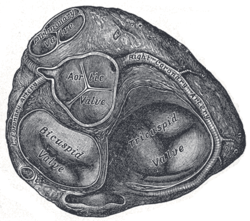Tricuspid valve
| Tricuspid valve | |
|---|---|
.svg.png) Anterior (frontal) view of the opened heart. White arrows indicate normal blood flow. (Tricuspid valve labeled at bottom left.) | |
 Base of ventricles exposed by removal of the atria. (Tricuspid valve visible at bottom right.) | |
| Details | |
| Identifiers | |
| Latin |
Valvula tricuspidalis, valva atrioventricularis dextra |
| MeSH | A07.541.510.893 |
| TA | A12.1.02.003 |
| FMA | 7234 |
The tricuspid valve, or right atrioventricular valve, is on the right dorsal side of the mammalian heart, between the right atrium and the right ventricle. The function of the valve is to prevent back flow of blood into the right atrium.
Structure
The normal tricuspid valve usually has three leaflets and three papillary muscles. They are connected to the papillary muscles by the chordae tendineae, which lie in the right ventricle. Tricuspid valves will not always consist of three leaflets and may also occur with two or four leaflets; the number may change during one's lifetime.[1]
Function
The tricuspid valve prevents back flow of blood from the right ventricle into the right atrium during ventricular systole when it closes and allows blood to flow from right atrium into right ventricle during ventricular diastole when it opens. This valve is weakened by drug abuse. The back flow of blood is also known as regression or tricuspid regurgitation.[2]
Clinical significance
Tricuspid regurgitation is not uncommon in the tricuspid valve.
It is common for a valve to be infected resulting in endocarditis, in intravenous drug users.[3][4] Patients who inject narcotics or other drugs intravenously may introduce infection, which will travel to the right side of the heart, most often caused by the bacteria S. aureus.[5] In other patients without a history of intravenous exposure, endocarditis is more frequently left-sided.[5]
The tricuspid valve can be affected by rheumatic fever, which can cause tricuspid stenosis or tricuspid insufficiency (also called tricuspid regurgitation).[6] Some patients are born with congenital abnormalities of the tricuspid valve. Congenital apical displacement of the tricuspid valve is called Ebstein's anomaly and typically causes significant tricuspid regurgitation.
Certain carcinoid syndromes can affect the tricuspid valve by producing fibrosis due to serotonin production by those tumors.
The first endovascular tricuspid valve implant was performed by surgeons at the Cleveland Clinic.[7]
Additional Images
- Tricuspid valve.Deep dissection.
References
- ↑ Richard Van Pragh: Cardiac anatomy in A. C. Chang et al.: Pediatric Cardiac Intensive Care, Philadelphia 1998.
- ↑ Healthline Editorial Team. "Right atrioventricular valve (Tricuspid valve)". Healthline.
- ↑ Demin AA, Drobysheva VP, Vel'ter OIu (2000). "[Infectious endocarditis in intravenous drug abusers]". Klinicheskaia meditsina (in Russian). 78 (8): 47–51. PMID 11019526.
- ↑ Butany J, Dev V, Leong SW, Soor GS, Thangaroopan M, Borger MA (2006). "Infective endocarditis of the tricuspid valve". Journal of cardiac surgery. 21 (6): 603–4. doi:10.1111/j.1540-8191.2006.00313.x. PMID 17073968.
- 1 2 Mitchell RS, Kumar V, Robbins SL, Abbas AK, Fausto N (2007). Robbins Basic Pathology (8th ed.). Saunders/Elsevier. pp. 406–8. ISBN 1-4160-2973-7.
- ↑ Tricuspid valve disease Mount Sinai Hospital, New York
- ↑ University Circle Inc.
External links
- Anatomy figure: 20:07-04 at Human Anatomy Online, SUNY Downstate Medical Center
- Photo of model at Waynesburg College circulation/tricuspidvalve04
- Cardiac Valve Animations - Perioperative Interactive Education Group - Cardiac Valve Animations